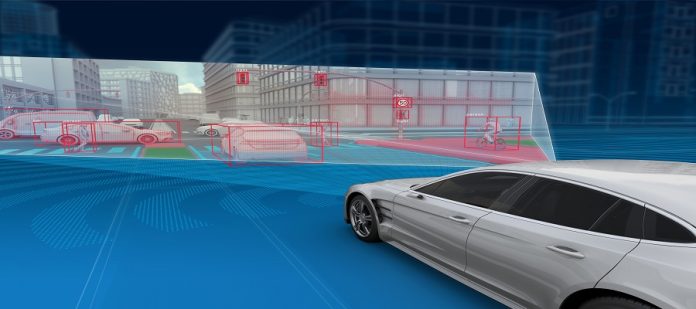Autonomous vehicles and robots heavily depend on radar technology to perceive and analyze their surroundings. This involves utilizing multiple front ends and MIMO antennas. However, the use of numerous radars introduces the problem of handling vast amounts of data, leading to various difficulties. To address these issues, Ambarella, a chipmaker based in California, aims to revolutionize the process with its latest innovation: a centrally processed 4D imaging radar system. This cutting-edge system enables centralized processing of raw radar data while also facilitating seamless integration and fusion of information from other sensors like cameras, ultrasonics, and lidar at a deep, fundamental level.
What are the benefits of centralizing processes? Centralized processing in AI-based advanced driver-assistance systems (ADAS) and L2+ to L5 autonomous-driving systems, including autonomous robots and drones, provides several advantages. Firstly, it enhances environmental perception and ensures safer path planning. To achieve this, Ambarella’s new system incorporates Oculii radar technology running on its 5-nm CV3 AI Domain Control SoCs, along with AI software algorithms that dynamically adjust radar waveforms based on the surrounding environment.
One of the significant benefits of this approach is that it utilizes fewer MIMO channels, leading to reduced data bandwidth and lower power consumption compared to other 4D imaging radars. Ambarella claims that their Oculii technology, featuring a centralized 4D imaging radar, presents a remarkably versatile and top-performing architecture. This advantage allows system integrators to future-proof their radar designs, making them adaptable to changing technological demands.
Cedric Malaquin, Team Lead Analyst of RF activity at Yole Intelligence, a part of Yole Group, revealed that approximately 100 million radar units were manufactured for automotive ADAS in 2021. He predicts that this volume will grow significantly, reaching 2.5 times its current size by 2027. The expected growth is attributed to more stringent safety regulations and the emergence of advanced driving automation systems on the roads. As a result, automobile manufacturers (OEMs) are transitioning from one to three radar sensors per car to a baseline of five radar sensors per car.
Furthermore, there is an intriguing discussion surrounding radar processing partitioning, accompanied by numerous developments. One of the approaches gaining attention is centralized radar computing. This approach empowers OEMs to provide highly efficient imaging radar systems and introduce new ADAS/AD features while optimizing the cost of radar sensing.
In order to implement the centralized system, Ambarella undertook several optimizations. They fine-tuned the Oculii algorithms to be compatible with their CV3 AI domain controller SoC family, using the advanced 5-nanometer geometries. Additionally, they integrated specialized radar signal-processing acceleration into the SoC. This integration allows the CV3 to deliver exceptional AI performance per watt, which is crucial for supporting the extensive radar density, range, and sensitivity required.
According to Ambarella, the CV3 SoC can handle multiple tasks simultaneously with high performance and real-time processing. These tasks include perception, low-level sensor fusion, and path planning, making it a versatile and powerful component for the centralized system.
However, it’s important to acknowledge that 4D imaging radar technologies do present their own set of challenges. One significant hurdle is the sheer size of the datasets generated by 4D radar, making it difficult to transport and process them centrally. Each module of these radar systems generates multiple terabits of data per second and consumes over 20 watts of power per radar module. Considering that a vehicle may require six or more radar modules to achieve adequate coverage, the cumulative data load becomes overwhelming for a central processor to manage.
Ambarella will tackle this challenge through several strategic approaches. In the initial stages, these radar systems make use of low-level signal sensor fusion, granting them the capability to adapt the scanning properties of vehicle radars based on distinct applications. For example, when parking, the system can adjust settings for field-of-view and range accordingly. This adaptive approach reduces the need for an extensive antenna array for each processor-less MMIC radar head while maintaining an impressive 0.5 degrees of joint azimuth and elevation angular resolution.
Furthermore, the centralized architecture implemented by Ambarella offers additional benefits. It significantly reduces power consumption at the maximum duty cycle, ensuring more efficient energy usage. Additionally, the system optimizes data transport by reducing the required bandwidth by an impressive 84%. These combined strategies enable Ambarella to effectively manage and overcome the challenges posed by 4D imaging radar technologies.
Moreover, the centralized architecture enables dynamic allocation of the processing resources within the CV3, adapting in real-time to prevailing conditions. For example, during highway driving in rainy conditions, the CV3 can prioritize data from front-facing radar sensors, extending the vehicle’s detection range and ensuring quicker response times.
Another advantage of the centralized system is the ease of over-the-air (OTA) software updates, allowing for continuous improvement and future-proofing of the technology.
As smart cars, particularly autonomous vehicles, become more prevalent on the roads, Ambarella’s centrally processed system appears highly appealing. However, the company has not disclosed the market release date or revealed which manufacturers have shown interest. Earlier, in January, they presented the technology at CES 2023, but since then, specific details have been kept confidential.










